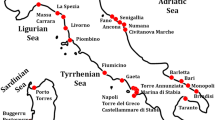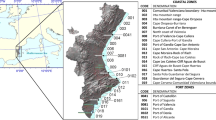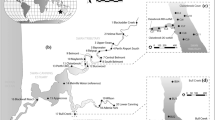Abstract
Introduction
A Norwegian system for classification of environmental quality of contaminated marine sediments has been in force since 1997 and was revised in 2007.
Discussion
The 1997 classification had five quality classes based on the statistical distribution of levels of the contaminants in sediments along the Norwegian coast.Class I represents background and classes II-V describe four intervals of concentrations mainly from a percentile division of the total distribution. The revised classification is based on toxicity of the contaminants. It covers 43 compounds against 28 in the 1997 version. It is based on European Union systems for defining environmental quality standards and performing risk assessment. Five classes are retained. Class I is kept as the background range. The upper limits for class II and class III are the Predicted No Effect Concentrations (PNEC) for chronic respectively acute (intermittent) exposure from the compound. The upper limit of class IV is 2-5 × PNEC intermittent depending on compound, and class V is everything above this. The border between class II and class III is most significant as it separates no-effects sediments from those for which sediment remediation may be needed.
Conclusion
The classification has been changed from concentration based to effects based and is in harmony with the Norwegian guideline for risk assessment of sediments. The classification system should be intermittently revised to include new or improved environmental quality standards as they are approved by the European Commission.
Similar content being viewed by others
Explore related subjects
Discover the latest articles, news and stories from top researchers in related subjects.Avoid common mistakes on your manuscript.
1 Introduction
The first official system for classification of environmental state of Norwegian fjords and coastal waters was published by the Pollution Control Authorities (SFT) in a series of guideline documents during 1993-1994. The system comprised classification of selected marine sites with respect to environmental condition, pollution degree and suitability for use with reference to eutrophication and contaminant levels. The classification is based on analysis of water, sediment and organisms. The purpose was to provide a common tool for the authorities, industry and environmental consultants to describe environmental conditions, establish environmental aims, prioritise sites for abatement and remediation, and assess the success of such measures relative to commonly agreed acceptance criteria. In 1997, a revised and extended version of the system was published (Molvær et al. 1997), and this has been in use up to present. In 2007, the classification of contaminants in seawater and soft sediments was revised to place focus on ecotoxicity of the contamination rather than on contaminant levels (SFT 2007a). The present paper gives an outline of the purpose and use of the sediment part of the classification system, the scientific background, and how it has developed over the later years.
2 The 1997 classification system for contaminants
A common structure for all revisions has been the definition of five concentration intervals as classes ranging from background to the worst conditions encountered in the field. In the 1997 version (Molvær et al. 1997), these classes were defined on basis of the frequency distribution of concentrations for 18 contaminants (single compounds or compound groups) in the upper 0-5 cm of oxic, soft sediments (silt and clay). The basis for the frequency distribution was data gathered from national monitoring programmes in fjords and coastal waters in Norway and surveys for industry and local authorities in various marine recipients and outside point sources of contamination. The classes were not defined on basis of biological effects of the compounds, but as overconcentration intervals relative to what was considered to be background levels in areas with no apparent inputs. These overconcentrations were chosen either as percentiles of the overall distribution, known gradients around point sources, inherent properties of the compounds, expert assessment, or a combination of these. For mercury and dioxins, the health aspect was also included in the classification. As a result the classes were somewhat arbitrary (Table 1) and the background for their definition has become obscure over time.
3 The 2007 revised classification of contaminants
In 2004, the Norwegian Pollution Control Authorities decided to develop a guideline for environmental and health-driven risk assessment of marine sediments to be used primarily as supportive tool in the decision process on remediation of polluted harbour sediment. The risk assessment guidelines covered 35 inorganic and organic compounds and compound groups. They focussed on toxicity to aquatic organisms as well as impact on human health.
The risk guidelines were revised in 2007 and extended to cover 50 compounds and compound groups (Bakke et al. 2007). At the same time, it was decided to revise the classification of contaminants in sediment (and seawater) and to harmonise the two systems. The classification was extended to cover the same compounds as in the risk assessment guidelines, and a new approach to define the environmental quality classes was adopted (SFT 2007a, b). The concept of five classes based on concentration intervals was retained, but the definition of class borders was based on ecotoxicology and follows the principles of contaminant risk assessment in the European Community (European Commission 2003) as much as possible. Class border definition was based on Environmental Quality Standards given in the EU Water Frame Directive (Lepper 2005) and Predicted No Effect Concentrations (PNEC) from Risk Assessment Reports (RAR and Draft-RAR) available from the EU programme for risk assessment of existing chemicals. Supplementary information was extracted from OSPAR (2005a, b), RIVM (Crommentuijn et al. 1997), the IUCLID database (http://ecb.jrc.ec.europa.eu/esis/index.php?PGM=dat), the US EPA database ECOTOX (http://cfpub.epa.gov/ecotox/), and relevant scientific literature. The revised classification system is given in Appendix 1.
Class I in the revised classification (SFT 2007a) represents background levels in marine sediments as in the previous version (Molvær et al. 1997). For compounds brought forward from that version, the upper limit of class I was retained. For new compounds and individual member compounds from earlier groups (e.g., sumPAH), the background interval was provisionally determined from Norwegian screening surveys (OSPAR 2005a, b; Fjeld et al. 2005) and adjusted to 1% total organic carbon (TOC) which is more representative for Norwegian marine sediments than 2.5% TOC used by the Convention for the Protection of the Marine Environment of the North-East Atlantic (OSPAR). For a range of the new compounds, the lack of sufficient data has made it impossible to establish the upper limit of Class I (cf Appendix 1). The other classes (class II-V) represent increasing degree of damage to ecological communities in the free water masses or in the sediments. The basic information is data from laboratory tests on acute or chronic toxicity.
The upper limit of class II represents the concentration above which long-term exposure may cause effects on sufficient number of species to damage community structure and function. This class border is defined as the Predicted No Effects Concentration value for chronic exposure (PNECchronic). For compounds where a quality standard (QSsediment) is proposed in the EU Water Frame Directive, this is used as PNECchronic. For the other compounds, the PNECmarine.sediment outlined in the EU Risk Assessment Reports (RAR) is used when available, and for the remaining compounds the PNECchronic is calculated according to the guidelines in the European Commission (2003) EU-TGD. Equilibrium partitioning has been used to calculate PNECsediment, from PNECseawater for compounds where little data on sediment toxicity is available. The EU-TGD equilibrium partitioning calculations are based on suspended sediment with assumed 10% TOC, but a more realistic level of 1% TOC has been used to represent Norwegian seabed sediments.
The upper limit of class III is defined as the concentration for which exceedance over short periods of time could damage ecological communities. Maximum Admissible Concentration Quality Standard or PNECintermittent (equivalent to PNECacute) are used for seawater if available from official EU documents after which equilibrium partitioning calculations are used to calculate the PNECacute for sediments giving the upper border of class III. Alternatively, an acute/chronic ratio equal to the PNECacute/PNECchronic for seawater is used to calculate the PNECacute.sediment. For some compounds, the PNECacute.sediment is calculated according to RAR and QS documents of the EU from short-term toxicity tests and applying appropriate assessment factors (AF) as outlined in the EU-TGD. For some metals species, sensitivity distributions for acute toxicity are available and have been used, with an appropriate AF, to define the PNECacute.sediment.
The border between class IV and class V denotes concentrations above which more severe community effects are expected from short-term exposure. The border is calculated as the PNECacute.sediment multiplied by the ratio between the borders of class III-IV and class IV-V for seawater (the latter being calculated in the same way as for the border between class III and IV, but using lower AFs).
The principles of class definition are illustrated in Fig. 1. Using the EU-TGD principles strictly to determine PNEC values has created some practical problems due to the very conservative AFs for chemicals with limited toxicity data. For many compounds, this has resulted in PNECs well within the background range given by OSPAR (2005a, b) and also below the detection limits achieved in high quality analytical laboratories. Also the information on toxicity may be very different among compounds of similar molecular structure (e.g., individual PAH components) resulting in unlikely differences in PNECs. Hence, strict coherence to the EU risk assessment principles was considered not to produce a useful tool for environmental management. It has therefore been decided to omit two of the AFs that are considered to represent the least increase in the risk of underestimating the environmental hazard: (a) an AF of 2-10 for extrapolation of freshwater toxicity data to marine organisms and (b) an AF of 10 to account for exposure through ingestion of sediment for substances with logKOW >5. These deviations from the EU-TGD principle was adopted by the authorities on a pragmatic basis pointing out that the PNECs will have to be revised as new toxicity data become available.
Principles of the Norwegian environmental quality classification system for contaminants in seawater and sediments (SFT 2007a); for abbreviations see text
In addition to the classification of single compounds, some compound groups that traditionally have been particularly valuable in environmental management are classified: sumPCDD/PCDF, sumPCB7, and sumPAH16. For these, it has not been possible to use the principles above. Hence, for sumPCDD/PCDF and sumPAH16 in sediments the classification in Molvær et al. (1997) is retained. For sumPCB7, a US classification system by MacDonald et al. (2000) has been adopted. For tributyl tin in sediments the previous classification (Molvær et al. 1997) has been retained for management purpose since the effects based classification outlined above (also included) has resulted in extremely low levels relative to those found in open Norwegian coastal areas.
To ensure transparency in the definition of the classes a background document has been published outlining and explaining the calculations and presumptions made for each of the compounds (SFT 2007b).
4 Implication for sediment management
The revised classification system shall serve the same purposes as the 1997 version, i.e., being a tool for classification of environmental quality of Norwegian marine areas and a support for evaluating the need for cleanup of contaminated sites. For a large number of sites, the development in environmental quality of the sediments has been followed over long time by use of the 1997 classification, even since before it was published. Adopting the revised classification thus gives a discontinuity in such time series. The authorities have not requested that retrospective reclassification is done for such sites, and one must assume that for several of them the old classification will still be used for comparison reasons. For environmental risk considerations, only the revised system will be used. Hence, it is anticipated that the two systems will run in parallel for many years and with slightly different objectives for use.
The revised classification is more easily applied to potential sediment cleanup situations. It is obvious that an effects based classification is a more appropriate tool for evaluating the need for remedial actions than one based on distribution of concentrations alone. This is also the main reason why the classification has been closely linked to the Norwegian guidelines for risk assessment of contaminated sediments (Bakke et al 2007). In these guidelines, a three-step tiered risk evaluation is adopted based on the analysis of contaminants and toxicity of the sediments, and specified support parameters. Non compliance in tier 1 (environmental risk) triggers performance of a more thorough tier 2 (environmental and human health risk). Non-compliance of tier 2 triggers a sediment remediation planning process, alternatively a site-specific tier 3 evaluation, the non-compliance of which triggers the same planning process. The upper limits of class II in the classification system are equal to the acceptance criteria in tier 1 of the risk guidelines. Hence, exceedance of class II, even for only one of the compounds in question suggests a possibility of ecological damage and hence leads directly to a requirement of an environmental and human health risk assessment (tier 2). Compliance to class II is, however, not the only condition for not having to perform a tier 2 risk assessment. To cover for combined effects of contaminant mixtures (which is not included in the classification system) and toxicity of compounds not analysed for, tier 1 also includes acceptance criteria on general sediment toxicity based on selected screening tests.
5 Conclusions
The Norwegian classification of contaminants in sediments has moved from a system based on distribution of contaminant concentrations to one based on environmental effects and closely linked to the risk assessment principles of the EU. The present classification is also in harmony with the Norwegian guidelines for risk assessment of marine sediments and represents a useful tool for marine environmental management. The European Union risk assessment system is in continuous development and one must expect that new or improved quality standards will be developed and approved by the European Commission, and that new substances also will be included in the system in the future. The Norwegian classification and risk assessment systems should be intermittently revised to reflect these developments.
References
Bakke T, Breedveld G, Källqvist T, Oen A, Eek E, Ruus A, Kibsgaard A, Helland A, Hylland K (2007). Veileder for risikovurdering av forurenset sediment (guideline for risk assessment of contaminated sediment; in Norwegian). Norwegian Pollution Control Authority SFT TA-2230/2007
Crommentuijn T, Polder MD, van der Plassche EJ (1997) Maximum permissible concentrations and negligible concentrations for metals, taking background concentrations into account. RIVM Report No 601501 001, The Netherlands
European Commission (2003) Technical Guidance Document on Risk Assessment in support of commission directive 93/67 on risk assessment for new notified substances, commission regulation (EC) no 1488/94 on risk assessment for existing substances and Directive 98/8/EC of the Parliament and of the Council concerning the placing of biocidal products on the market. ISBN 92-827-8011-2
Fjeld E, Schlabach M, Berge JA, Green N, Eggen T, Snilsberg P, Vogelsang C, Rognerud S, Kjellberg G, Enge EK, Dye CA, Gundersen H (2005) Kartlegging av utvalgte nye organiske miljøgifter 2004. Bromerte flammehemmere, perfluoralkylstoffer, irgarol, diuron, BHT og dicofol. (Mapping of selected organic contaminants 2004. Brominated flame retardants, perfluoroalkylated compounds, irgarol, diuron, BHT og dicofol). Norwegian Institute for Water Research NIVA Report No 5011-2005 (in Norwegian)
Lepper P (2005) Manual on the methodological framework to derive environmental quality standards for priority substances in accordance with Article 16 of the water framework directive (2000/60/EC). Fraunhofer-Institute Molecular Biology and Applied Ecology, Smallenberg
MacDonald DD, Ingersoll CG, Berger TA (2000) Development and evaluation of consensus-based sediment quality guidelines for freshwater ecosystems. Arch Environ Contam Toxicol 39:20–31
Molvær J, Knutzen J, Magnusson J, Rygg B, Skei J, Sørensen J (1997) Klassifisering av miljøkvalitet i fjorder og kystfarvann (Classification of environmental quality in fjords and coastal areas). Norwegian Pollution Control Authority SFT TA-1467/1997 (in Norwegian)
OSPAR (2005a) Agreement on background concentrations for contaminants in seawater, biota and sediment (OSPAR Agreement 2005-2006)
OSPAR (2005b) 2005 assessment of data collected under the Co-ordinated Environmental Monitoring Programme (CEMP). OSPAR Commission Publication No 2005/235
SFT (2007a) Veileder for klassifisering av miljøkvalitet i fjorder og kystfarvann. Revidering av klassifisering av metaller og organiske miljøgifter i vann og sedimenter (Guidelines for classification of environmental quality in fjords and coastal areas. Revision of classification of metals and organic contaminants in water and sediment). Norwegian Pollution Control Authority SFT TA-2229/2007 (in Norwegian)
SFT (2007b) Bakgrunnsdokument Del B for: Veileder for klassifisering av miljøkvalitet i fjorder og kystfarvann: og Veileder for risikovurdering av forurenset sediment (Background document Part B for: Guidelines for classification of environmental quality in fjords and coastal areas: classification of metals and organic contaminants in water and sediment and Guideline for risk assessment of contaminated sediment). Norwegian Pollution Control Authority SFT TA-2231/2007 (in Norwegian)
Author information
Authors and Affiliations
Corresponding author
Additional information
Responsible editor: Gijs D. Breedveld
Rights and permissions
About this article
Cite this article
Bakke, T., Källqvist, T., Ruus, A. et al. Development of sediment quality criteria in Norway. J Soils Sediments 10, 172–178 (2010). https://doi.org/10.1007/s11368-009-0173-y
Received:
Accepted:
Published:
Issue Date:
DOI: https://doi.org/10.1007/s11368-009-0173-y





